Planning your big day involves countless details, and capturing those precious moments requires careful preparation. A well-organised checklist ensures nothing is missed when working with your photographer.
From professional equipment to personal touches, this guide covers must-have items for stunning wedding day images. Drawing from years of experience, we highlight both technical gear and practical considerations for UK couples.
Whether you’re hiring a professional or handling shots yourself, these insights help preserve memories beautifully. The right preparation makes all the difference in creating timeless photographs you’ll cherish forever.
Key Takeaways
- Professional cameras and lenses ensure high-quality captures
- Backup equipment prevents missed moments
- Lighting tools adapt to British weather conditions
- Comfortable footwear keeps photographers mobile
- Detailed shot lists guarantee important memories aren’t overlooked
Essential Camera Equipment for Wedding Photography
Capturing once-in-a-lifetime moments demands reliable photography gear that performs flawlessly under pressure. Professional wedding photographers rely on robust equipment to handle fast-paced ceremonies and unpredictable British weather.
Choosing Between DSLR and Mirrorless Cameras
The debate between DSLR and mirrorless systems continues among professionals. Traditional DSLRs like the Nikon D850 remain popular for their exceptional colour consistency and optical viewfinders.
Modern mirrorless cameras offer distinct advantages:
- Lighter weight reduces fatigue during long shoots
- Superior autofocus in low-light situations
- Silent shooting modes for discreet ceremony coverage
Many photographers now opt for hybrid setups. The Nikon Z8 with FTZII adapter allows seamless use of existing lenses while benefiting from mirrorless technology.
Why You Need a Backup Camera Body
Equipment failure isn’t an option when documenting irreplaceable moments. 64% of professionals carry two camera bodies to safeguard against technical mishaps.
Identical backup bodies offer crucial benefits:
- Muscle memory remains consistent during fast-paced changes
- Identical controls prevent fumbling during critical shots
- Matching colour science ensures uniform image quality
Comfort matters when working with dual cameras. Specialised harness systems from brands like Holdfast distribute weight evenly across your shoulders, allowing you to focus on capturing perfect moments rather than adjusting gear.
Remember – weddings can’t be restaged. Investing in reliable backup equipment provides peace of mind when documenting these precious memories.
What Do You Need for Wedding Photography? Essential Gear Checklist
Quality gear makes all the difference when documenting life’s most important events. Professional wedding photographers rely on carefully selected equipment to capture every smile, tear and dance move with precision.
Full-Frame vs Crop-Sensor Cameras
Sensor size significantly impacts image quality in wedding photography. Full-frame cameras like the Canon EOS R6 deliver superior performance in low light situations, crucial for dimly lit venues.
Crop-sensor alternatives offer practical advantages:
- More affordable entry point for new photographers
- Extra reach for ceremony shots from a distance
- Compact size for discreet moments
Many professionals carry both types. A full-frame body handles portraits while a crop-sensor camera captures distant moments without lens changes.
Top Camera Models for UK Photographers
The British market offers excellent options across budgets. The Nikon D850 remains a DSLR favourite at around £2,800, renowned for its colour accuracy.
Mirrorless alternatives shine with modern features:
- Sony A7IV (£2,400) – Outstanding autofocus for moving subjects
- Canon EOS R6 (£2,100) – Excellent low-light capabilities
- Fujifilm X-T5 (£1,600) – Film simulations for creative looks
Remember to factor in lens costs when budgeting. Many photographers start with one professional body and add second-hand equipment as they grow.
Selecting the Right Lenses
The right glass makes all the difference between snapshots and stunning professional images. Your lens collection determines how you capture emotions, venues, and intricate details throughout the celebration.
British photographers face unique challenges with changeable light and historic venues. Choosing adaptable optics ensures beautiful results regardless of conditions.
Prime vs Zoom Lenses: Making the Choice
Professional photographers debate prime versus zoom lenses constantly. Each option serves different purposes in creating memorable images.
| Feature | Prime Lenses | Zoom Lenses |
|---|---|---|
| Sharpness | Exceptional edge-to-edge | Good (high-end models excellent) |
| Low Light Performance | Wider apertures (f/1.2-f/1.8) | Typically f/2.8 or slower |
| Versatility | Requires lens changes | Single lens covers multiple focal lengths |
| Weight | Lighter individual units | Heavier but replaces multiple primes |
78% of professionals use a 24-70mm zoom as their primary lens. The Tamron 70-200mm f/2.8 remains popular for ceremony flexibility when movement is restricted.
Essential Focal Lengths Explained
Three focal lengths form the backbone of wedding photography:
- 24mm – Perfect for venue shots and large group photos
- 50mm – Natural perspective for candid moments
- 85mm – Flattering compression for portraits
The Sigma 35mm ART f/1.4 delivers breathtaking wide shots, while the Nikkor 85mm f/1.8 creates dreamy portrait bokeh. For ring shots and detail work, consider a 105mm macro lens.
“I never shoot a wedding without my 50mm prime – it sees the world as our eyes do, creating authentic emotional connections in images.”
Budget-conscious photographers should explore rental options for premium glass. Many London-based companies offer weekend rates for high-end lenses, making quality accessible for special occasions.
Lighting Equipment for All Conditions
British weather demands versatile lighting solutions for consistent results. From gloomy churches to candlelit receptions, the right flash setup preserves precious moments regardless of conditions. Professional photographers rely on adaptable gear to combat the UK’s unpredictable elements.
On-Camera Flash Versus Off-Camera Lighting
Choosing between attached and remote lighting depends on venue constraints and creative goals. Each approach offers distinct advantages for capturing authentic emotions.
| Consideration | On-Camera Flash | Off-Camera Lighting |
|---|---|---|
| Setup Speed | Instant deployment | 5-10 minute preparation |
| Portability | Lightweight solution | Requires stands and triggers |
| Creative Control | Limited to bounce techniques | Full directional control |
| Venue Suitability | Ideal for crowded spaces | Best for controlled environments |
Bounce flash techniques work wonders in low-ceilinged venues. Angle your speedlight towards pale walls or ceilings to create soft, diffused illumination that flatters subjects naturally.
Best Speedlights for Low-Light Venues
These reliable models handle Britain’s challenging lighting scenarios:
- Godox V860III – LED assist light helps mirrorless cameras focus in dark receptions
- Yongnuo 560 IV – Budget-friendly AA battery operation for all-day events
- Harlowe Avant – Constant fill light for gloomy churches and overcast outdoor shots
For historic venues like castles or barns, pack lighting kits with adjustable colour temperatures. Match tungsten chandeliers (3200K) or daylight-filtered tents (5600K) to avoid mixed lighting issues.
Safety matters when working with stands in windy British conditions. Always weigh down lightweight equipment with sandbags. MagMod diffusers create natural-looking flash that complements rather than overpowers ambient light.
With the right lighting gear, you’ll capture every magical moment beautifully, regardless of the weather or venue challenges. Preparation ensures consistent results throughout the wedding day.
Memory Cards and Batteries: Avoiding Disasters
Technical failures can ruin even the most beautifully planned wedding photography session. Reliable memory cards and batteries form the unsung heroes of every successful shoot. Without proper preparation, you risk missing irreplaceable moments during crucial parts of the celebration.
High-Capacity SD Cards with Fast Write Speeds
Modern cameras demand high-performance storage solutions. The SanDisk Extreme Pro 128GB handles 4K video bursts effortlessly, with write speeds up to 140MB/s.
Key considerations for UK photographers:
- UHS-II cards clear buffers 3x faster than UHS-I during continuous shooting
- Dual slots (like Nikon D850’s XQD/SD combo) provide instant backup
- Beware counterfeit cards on marketplaces – stick to authorised retailers like Wex Photo Video
How Many Spare Batteries to Pack
British wedding days often span 12+ hours of continuous shooting. Professionals recommend:
- 3 batteries per camera body for full coverage
- 1 battery typically lasts 2-3 hours with moderate LCD use
- Label charged/spent batteries to avoid confusion
A London photographer’s nightmare: During the first kiss, their primary card failed. Thankfully, dual slots saved the moment. “That £20 card nearly cost me £2,000 in lost business,” they later admitted.
Invest in genuine accessories from trusted British suppliers. The few pounds saved on questionable batteries or memory cards could cost you priceless memories.
Practical Accessories for Wedding Photographers
Smart gear choices can transform a photographer’s experience during long wedding days. The right accessories improve comfort, efficiency, and security when working with valuable equipment.
Camera Harnesses and Straps for Comfort
Traditional neck straps strain shoulders during 12-hour shoots. Modern solutions like the Holdfast MoneyMaker distribute weight evenly across both shoulders, handling 4kg+ kits comfortably.
Key options for UK photographers:
- Dual-camera harnesses – Keep two bodies ready without swapping lenses
- Hip-mounted systems – Spider Holster prevents back pain during extended use
- Padded straps – Reduce pressure points during outdoor ceremonies
Leather harnesses develop character over time, while nylon alternatives suit budget-conscious professionals. Consider Holdfast’s range for durable solutions that last through multiple seasons.
Lightweight Bags for Easy Transport
British weather demands water-resistant protection for expensive gear. The Peak Design Everyday Messenger offers quick access while meeting airline carry-on restrictions for destination weddings.
Essential features to consider:
- Separate compartments for bodies, lenses, and accessories
- Discreet designs that don’t attract attention
- Anti-theft zippers for crowded receptions
Bum bags provide instant access to batteries and lens wipes. For larger kits, wheeled cases like the Pelican 1535 Air navigate cobbled streets and airport terminals with equal ease.
Remember – comfortable photographers capture better images. Investing in ergonomic solutions pays dividends throughout long celebration days.
Comfort and Preparedness on the Wedding Day
Long hours and unpredictable conditions demand thoughtful preparation beyond camera gear. The difference between exhausted and energised work often shows in the final gallery. Smart choices about attire and supplies keep photographers focused on capturing emotions rather than discomfort.
Smart Yet Practical Outfits
British weather requires adaptable clothing choices throughout the seasons. Breathable linen suits work well for summer marquees, while thermal layers prove essential for winter castle shoots. Many professionals opt for stretch fabrics that allow free movement during crouched or elevated shots.
Footwear makes or breaks a photographer’s day. Doc Martens handle autumn mud beautifully, while Birkenstock sandals keep feet cool during heatwaves. Look for styles with arch support to manage hours on cobblestones or uneven grass.
- Hidden pockets secure memory cards and lens caps
- Dark colours minimise visibility during ceremonies
- Waterproof outer layers for sudden showers
Snacks, Hydration and Emergency Supplies
With 68% of UK venues forgetting vendor meals, packing sustenance becomes crucial. Collapsible water bottles fit in camera bags better than bulky venue glasses. Energy bars and nuts provide quick fuel between key moments in the schedule.
Every seasoned professional carries an emergency kit with:
- Plasters for unexpected blisters
- Paracetamol for headaches
- Stain remover pen for cocktail hour mishaps
- Portable phone charger
“I schedule snack breaks every 90 minutes – hungry photographers miss subtle emotional moments.”
Consider timing nourishment around natural lulls in the day. The golden hour between ceremony and reception often provides the best opportunity to refuel without missing important shots.
Conclusion
Perfect wedding photos start with the right preparation and reliable equipment. Prioritise dual camera bodies, fast memory cards, and comfortable footwear to handle long celebration days.
Balance technical gear quality with practical needs. Test all items beforehand to avoid last-minute surprises. New photographers can build kits gradually through rental services.
Create a printed checklist for the big day. This simple step ensures no crucial backup batteries or lenses are forgotten in the morning rush.
With thoughtful planning, you’ll capture every magical moment beautifully. The right photography tools transform fleeting emotions into timeless memories. Wondering how many hours of wedding photography you’ll need? This timeline breakdown can help you plan every shot.
FAQ
Should I choose a DSLR or mirrorless camera for weddings?
Both work well, but mirrorless cameras like the Sony A7 IV or Canon EOS R6 offer silent shooting and better autofocus, which is ideal for ceremonies.
Why is a backup camera body necessary?
Technical failures happen. A second body ensures no moments are missed if your primary camera malfunctions.
Are full-frame cameras better than crop-sensor for weddings?
Full-frame sensors, such as those in the Nikon Z6 II, handle low light better and offer a wider field of view, but crop-sensor cameras can work too.
What lenses are essential for wedding photography?
A 24mm for wide shots, a 50mm for versatility, and an 85mm for portraits cover most scenarios. Fast primes like the Sigma 35mm f/1.4 are excellent.
Is a speedlight necessary for indoor weddings?
Yes. A reliable speedlight like the Godox V1 helps balance dark venues and harsh shadows.
How many memory cards should I bring?
At least three high-capacity cards (128GB+) with fast write speeds to avoid running out of space mid-event.
What’s the best way to carry gear comfortably?
A dual-camera harness from BlackRapid keeps weight balanced, while a lightweight backpack like the Peak Design Everyday holds extras.
What should I wear as a wedding photographer?
Smart but practical attire—dark colours blend in, and comfortable shoes are a must for long hours on your feet.
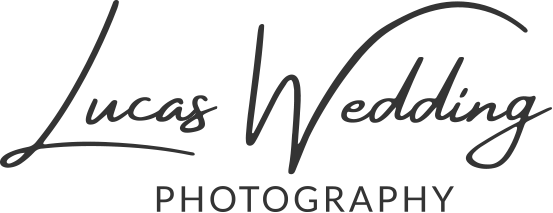
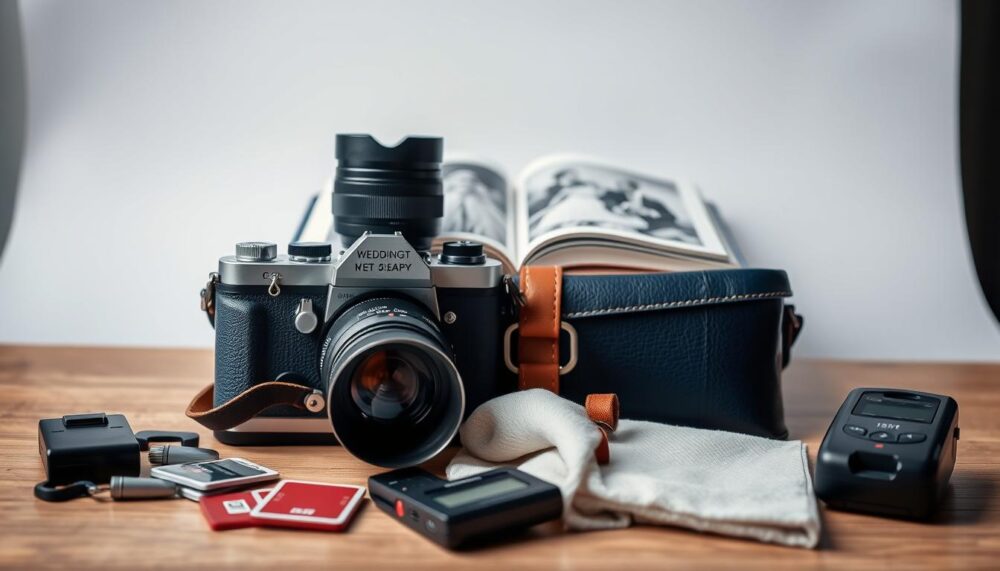
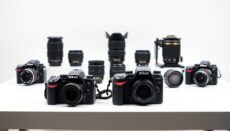

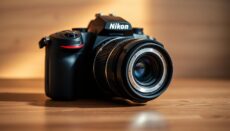
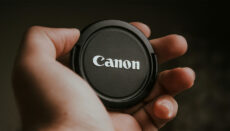
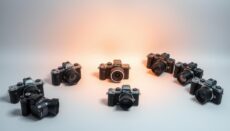
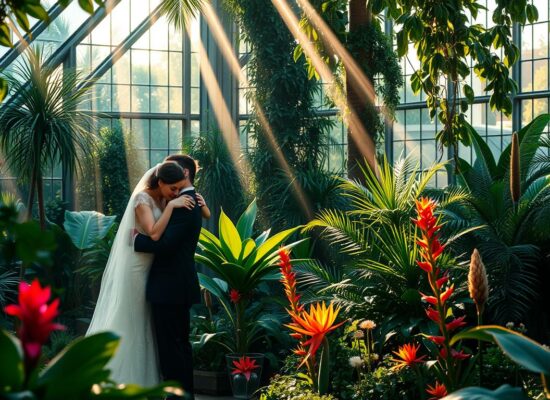
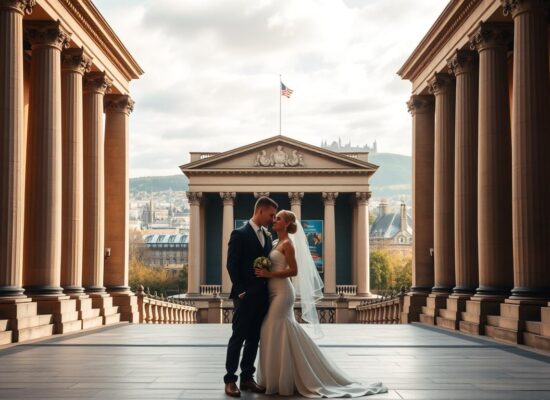
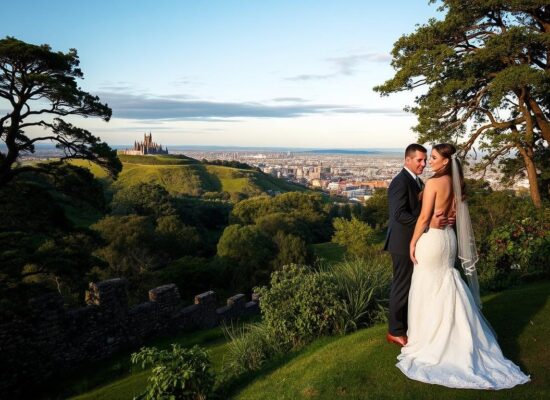
One thought on “What Do I Need for Wedding Photography? Essential Checklist for Couples”